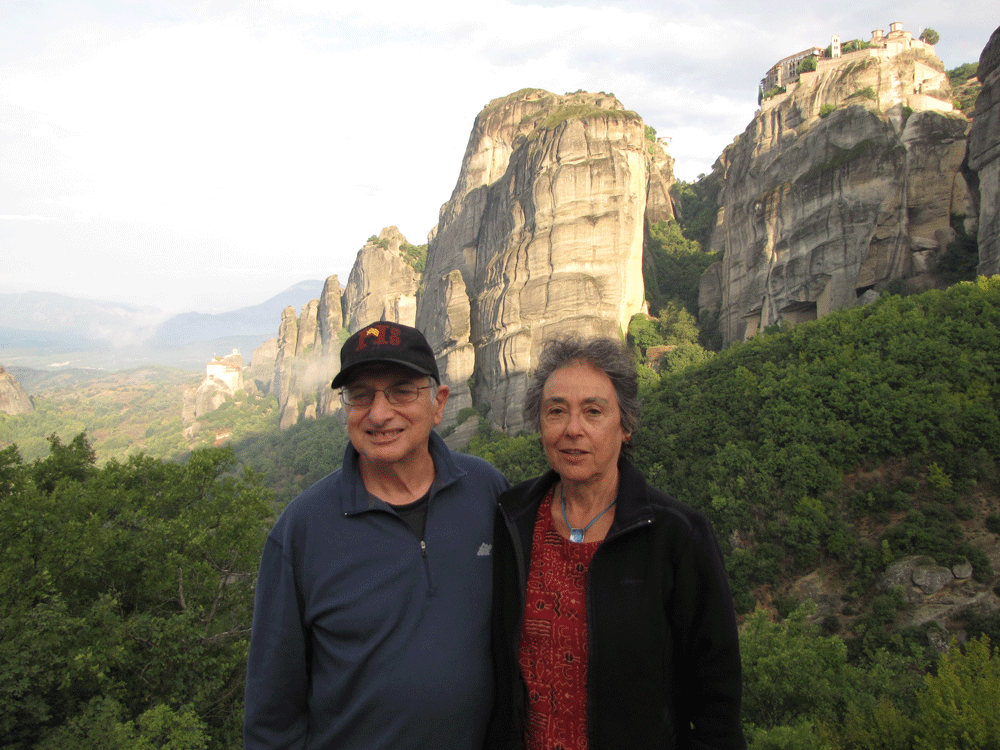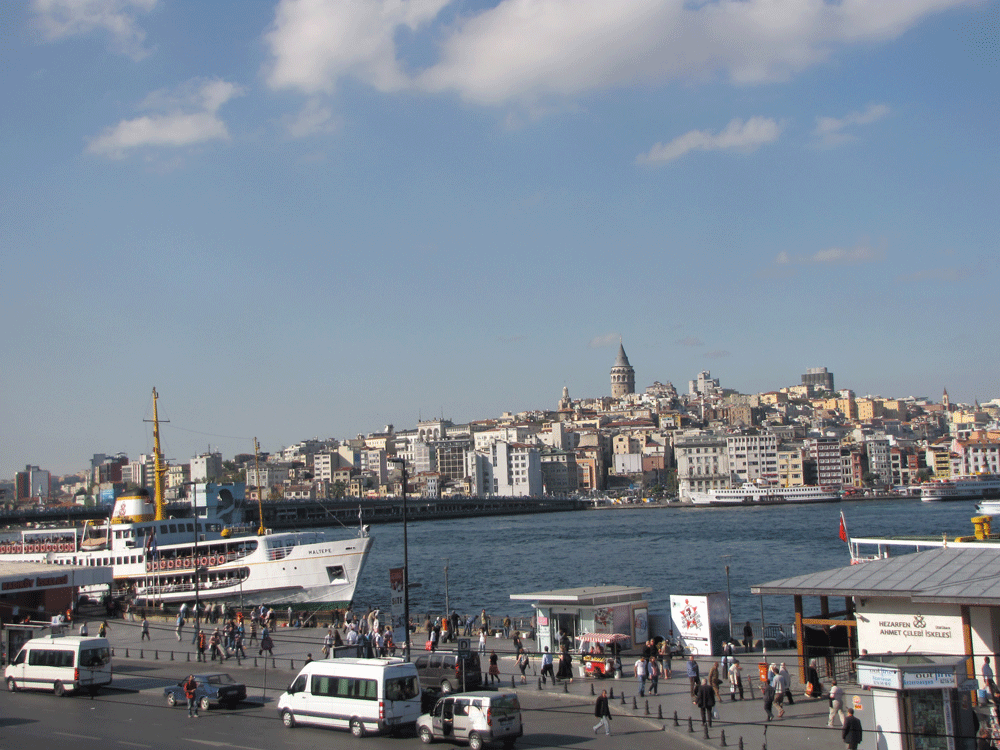Susan had never been to Turkey, nor I to Greece; so we went to both.
Greece had a further incentive: our Greek-American friend Costas and his wife Madeleine own homes in Athens and Mykonos. It was time to accept their invitation to visit.
A bit of a rocky start: At JFK Madeleine was threatened with a $150 baggage surcharge for eight pounds of overweight; and when her artistís portfolio arrived in Athens it was in ruins. Then Costas reported from Mykonos that he might have the swine flu, and Susan lost her wallet. None of this prevented us from enjoying Athens. The apartment is in Kolonaki, a classy residential neighborhood. The Acropolis is a brief walk away. For those of you who havenít seen it, I can report that it is indeed impressive. The Parthenon is magnificent, despite all the damage it has endured the past few thousand years and the presence of scaffolding and machinery. Its sheer size is overwhelming--no photograph can do it justice. Imagination can picture it with all its columns and a roof, with a brightly-colored frieze. Many artifacts may be seen in the enormous Acropolis Museum, which was opened only this June. Until the end of 2009 the admission charge is only one Euro. I think we may expect a substantial increase. The museum location was controversial: right in the middle of the city, with hardly any space for parking.
Other ruins are scattered about the city. Athens is otherwise a large, modern city without a lot of architectural attraction. It has a lot of narrow streets that provide enjoyable wandering. Watch your step on the broken sidewalks. There is a lot of outdoor eating and smoking. Donít try to drive. The lights are set two ways: green for vehicles and red for pedestrians. Like the other places we visited, Athens is not cheap, given the exchange rate of more than $1.40 per Euro. Good restaurants abound. One evening Costas drove us to one of his favorites, in an obscure area that we would not otherwise have found. We shared the dishes: little fish (very salty); big fish; calamari; shrimp. Also beer. All very good, for perhaps $30 per diner.
Costas did not have the flu, so we joined him in Mykonos. The way to get there, as with all the hundreds of Aegean islands, is by ferry. We took a fast one, which took about three hours. Costas met us at the dock with his rented Opel. He can remember when there was only one car on the entire island, and you traveled by donkey. Now the place has been built into a tourist haven. Costasís house is out of town, on a rocky hillside. Like most others, it is whitewashed. (There is a lot of rock on these islands.) It is small but light and comfortable, with a private lower floor that we occupied. Several beaches are a few minutesí drive away. They are uncrowded, at least in September, and very Mediterranean: recliners with umbrellas for rent, and women sunning their breasts. The water was fairly calm, and still warm enough for swimming.
The island of Delos, an hourís ferry from Mykonos, is the birthplace of Artemis and Apollo. It is a small island, with only 14 inhabitants as of 2001. In ancient times there were 30,000. How they fit, I cannot imagine. I doubt they had much of a sewage system. Today the place is rich with ruins, only a few of which have been restored: huge columns, etc. There is a fine museum that includes statuary that has been brought in from the weather.
Susan and I wanted another island, so we ferried off to Naxos, where Ariadne spent some time. It resembles Mykonos, but is rather less touristed. We arrived at 10:15 on Sunday night to find all the shops open. As is the case in many other warm parts of the world, they typically close much of the afternoon. The island town is hilly and compact, good for walking. We recommend especially the ďlabyrinth,Ē a warren of lanes and shops in which it is a pleasure to be lost. And we heard some local music in a cramped museum space where we could hardly see the performers. The free shots of wine (also local) were uplifting.
We returned to Athens for a quick overnight and then embarked on a 4-day bus tour. The bus held 50, but happily there were only 19 of us. Our Greek guide, a small middle-aged lady, spoke fine English and knew almost everything. The trouble was that she could keep none of it to herself, even when most of us would have preferred silence. She had to follow the script of the company, fittingly called Chatours. She was also testy at times, as when she reprimanded one of the group for photographing a tree instead of following her talk about the latest ruin. Nevertheless the trip was instructive and pleasurable. We started with the Peloponnese. Getting there starts with a crossing of the canal that cuts through the famous isthmus, just a few miles across. The canal was built late in the 19th century. It is very narrow and almost 300 feet deep. The water is blue and narrow; the walls are nearly vertical rock. Donít drive fast, or you will miss it.
The Pelopennesian ruins are stupendous. Check out the tomb of Agamemnon (some skeptics doubt his presence there). Delphi and especially Olympia are extensive; there has been some restoration, as well as much excavation, with more to come. The ancient Olympic games come alive here (with appropriate imagination). Reaching Delphi meant leaving the Peloponnese by the Rio-Antirro bridge that spans the Gulf of Corinth. Itís cable-stayed, and nearly two miles long. This miraculous and beautiful structure was opened in August 2004, just in time for the Athens Olympics. It has replaced most of the 50 ferries that once plied these waters, but some remain because fuel carriers are prohibited on the bridge.
Our final tour day was at the justly celebrated Meteora monasteries (Greek Orthodox). More than 24 of those are perched--thatís the only word--on top of fantastic eroded conglomerate rock spires. The oldest are from the 14th century. They reminded us of the Tigerís Nest in Bhutan. (Rock climbing is permitted in parts of the area. It looks really forbidding: steep and mostly crackless.) You could easily spend a day here, but we had only a few hours before the long drive back to Athens.

Tour note: even in late September all these sites were crowded. There were many other bus loads, and large groups being guided in various languages. They are polite but numerous. Our own group was mostly American and middle-aged or more. Some looked even older than we! But there was a young honeymoon couple who live near my former house in the Adirondacks. She works for a Planned Parenthood clinic in Plattsburgh. Those of you familiar with North Country culture know that hers is a stressful assignment. Our final week was in Istanbul. Costas, being Greek, hesitated to go there. He finally agreed under condition that we call the city ďConstantinople.Ē We threatened to banish him to another hotel if he misbehaved. In the event, he loved the place and envisioned a return--itís only 80 minutes by jet from Athens.
When you arrive at the Ataturk International Airport, do not head for the (lengthy) passport line. Rather, go to the visa section, where you pay $20 for a visa stamp. Then the passport line, where a mysterious device takes your temperature without your knowing it (swine flu, you know). Then a taxi to your hotel--in our case the Seven Hills in Sultanahmet. This is the neighborhood in the western section below the Golden Horn. It is very close to many places you will want to visit. The only trouble with this hotel, at least on September 29, 2009, was that one restaurant floor, just below the roof, was under vigorous reconstruction. Hammering and huge crashes rattled the building. Several large metal window frames were lowered by rope just outside our balcony. We were mollified by a room on a lower floor, a promise (almost kept) that the work would soon be finished, and a free dinner in the functioning part of the restaurant. This is on the roof, with spectacular views. The room minibar offered beer, chocolate and condoms.

I had been in Istanbul in 1965, en route to Afghanistan for a climbing trip. A lot has changed since then. No longer a city of a million or so, Istanbul has now perhaps 12 million or 15 million--doubtful that anyone really knows. One of memories of the earlier trip is driving our Land Rover onto a ferry to cross the Bosphorus into Asia. Now there are two bridges, with a third in prospect. Four bridges span the Golden Horn. Once we tried the tram system, which requires a token (about $1.00). We were very pleased with our resourcefulness until we realized that we were heading the wrong direction. Despite its vastness of the city, many of the most compelling sights may be reached on foot. A number are just a few minutes from our hotel: Hagia Sophia, the huge church turned mosque turned museum; the sprawling Topkapi Palace; the Blue Mosque. I will not try to describe these amazing historical sites. For the first two, we engaged a professional guide: Mustafa Barlak, aged 81. At Sophia we saw the Obama cat--so named because petted by the President on his recent visit. At least this was supposed to be the genuine article--cats abound in Greece and Turkey.
Another virtue of walking is that you donít have to be in a taxi. Surprising few of the drivers speak English. Most of them used their meters and did their best in the crowded anarchy of the streets and highways. But they sometimes have to stop to ask directions. We did have one driver who seemed to be on a controlled substance. He avoided traffic by zooming down a wrong-way street. The police stopped him but let him continue, to our dismay.
Turkish is a difficult language. Donít try to learn it unless you plan to be in the country for at least two years. Some exotic Turkish words: polis, taksi, otopark, fotokopi, internet. Thanks to our difficult hotel tv, I also learned the Turkish for ďno signal.Ē Itís ďsinyal yok,Ē in case you need it. When the set worked, it had 1000 channels. They were in many languages, including Italian, Arabic, Polish, Sex, Russian, and English. The sex channels were hot, hard, and gay, among many others.
Itís nearly obligatory to see some whirling dervishes. We signed for a performance enticingly called ď800 years of love.Ē It lasted one hour. Musicians played for a time. Then four solemn dervishes came out and whirled. I couldnít see their feet, so I donít know how they managed it.
We had been away more than two weeks without coming across anyone we knew from Brooklyn! Then in the market Susan bumped into Paulette and Ira, who joined the four of us for dinner. Dining in the city is very good indeed, as I recalled from 1965. Our favorite place was Rima, a couple of blocks from the hotel. We ate there the last two evenings.
Is Turkey an Islamic country? Istanbul abounds in mosques--minarets visible everywhere. Calls to prayer (recorded) sound loudly five times a day. On the other hand, alcoholic beverages are no problem.You can even find the well-known ďSex on the BeachĒ cocktail. As Susan had observed in Morocco, women in head scarves mingle freely with those dressed western style. We felt entirely comfortable asking directions to the synagogue and walking through untouristed neighborhoods. As to joining the European Union... far from clear. We met one sophisticated Turk who thought that an Islamic country would never get in. Hope heís wrong.
--Sept.-Oct. 2009